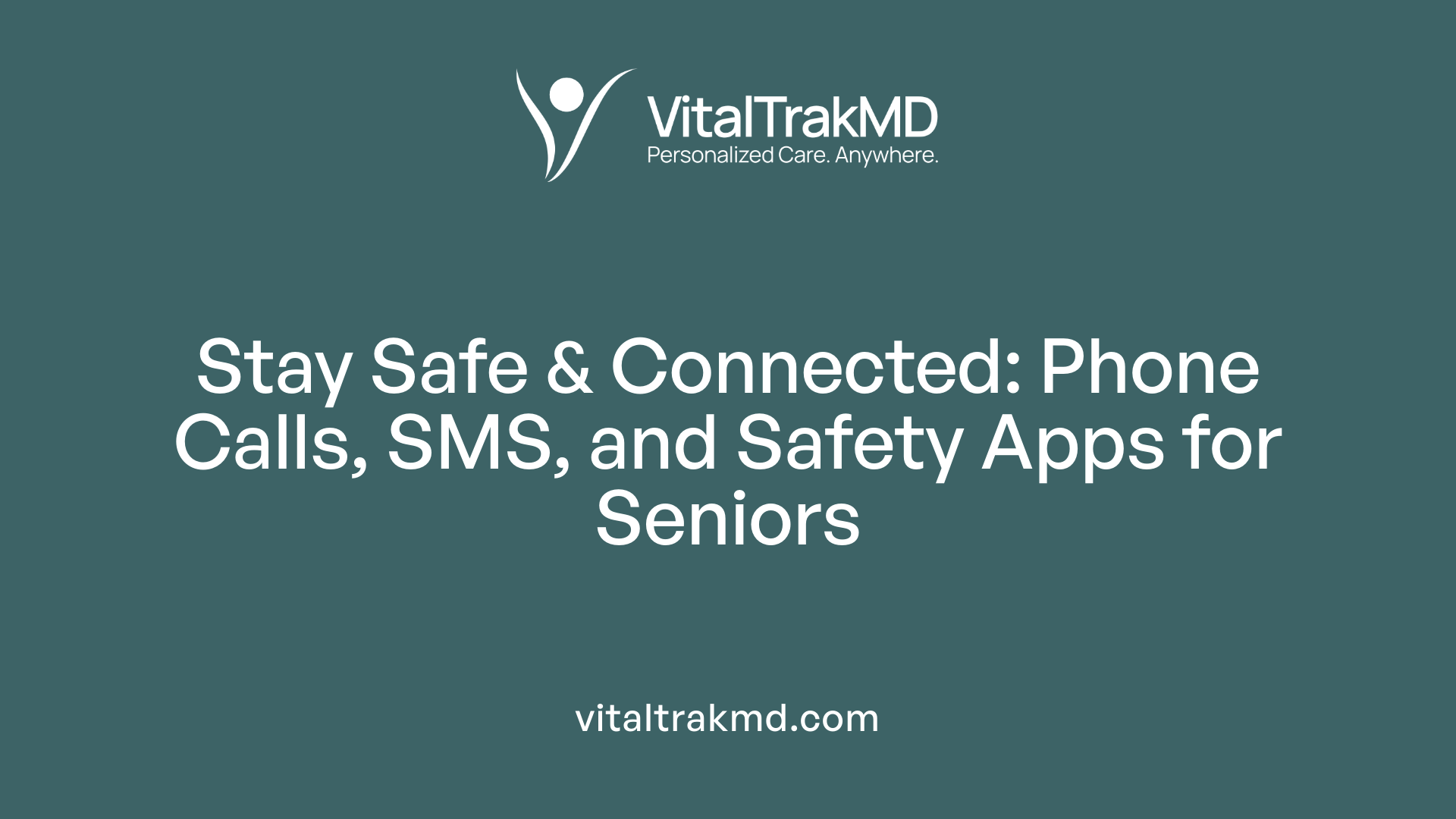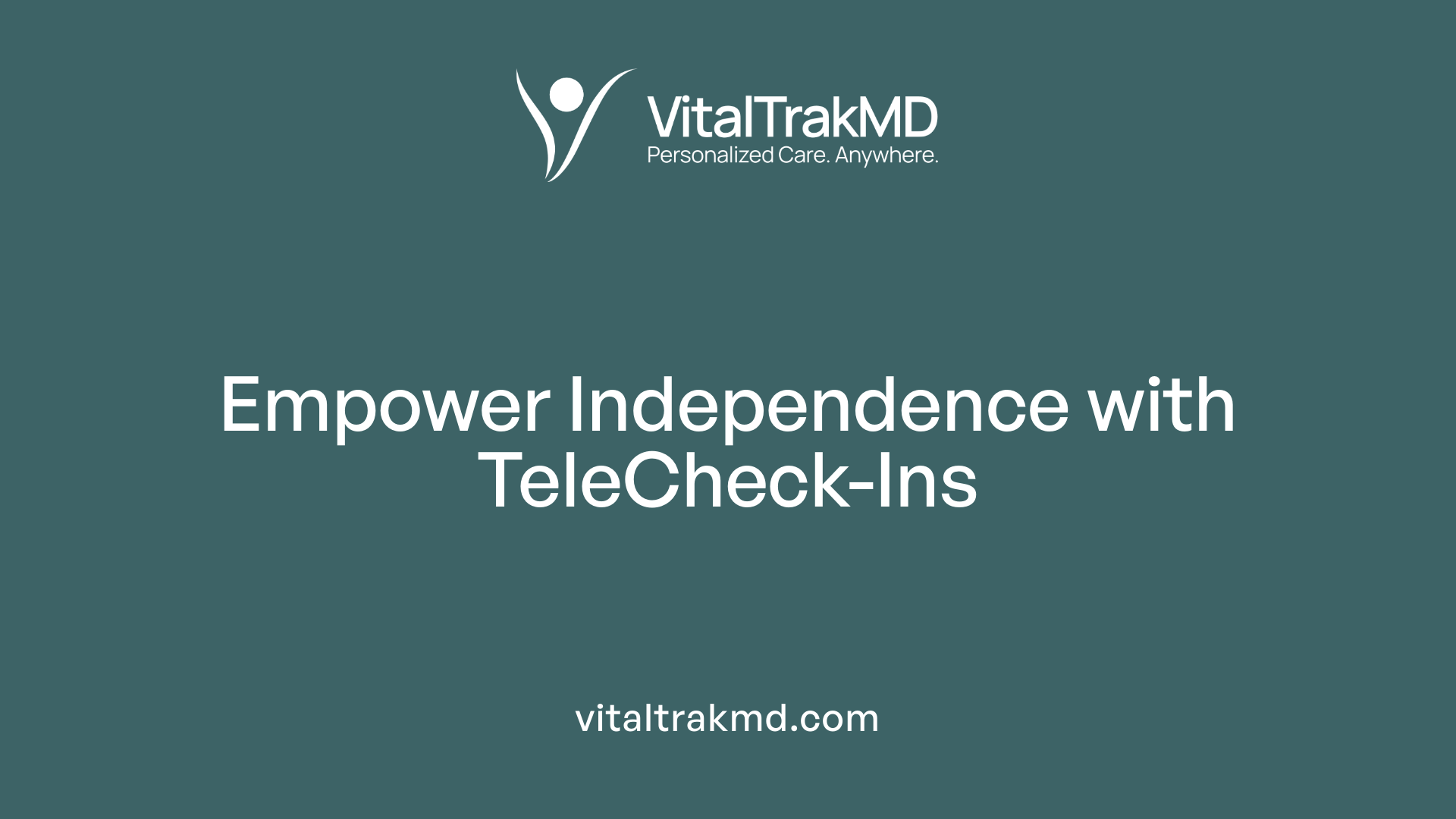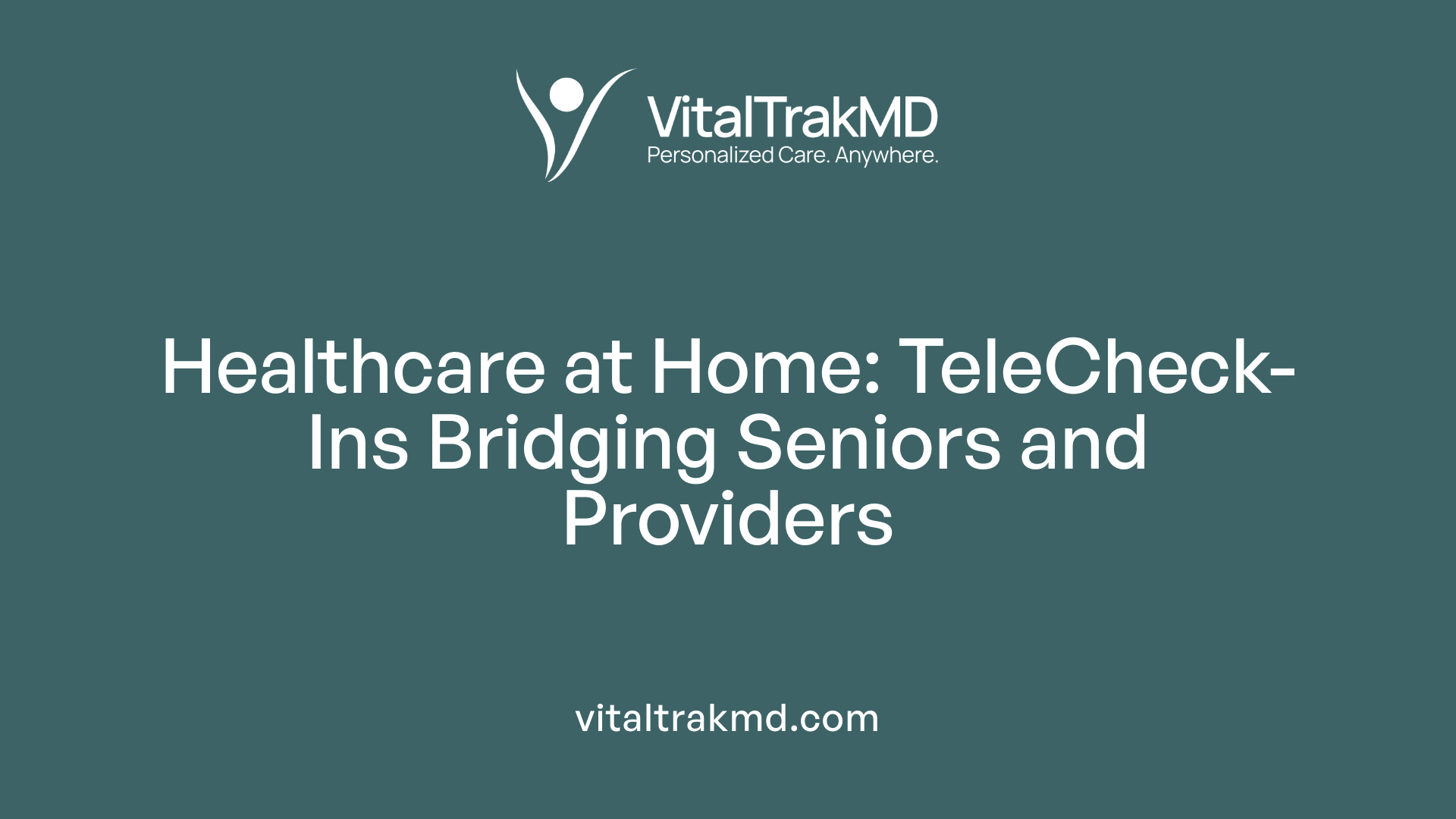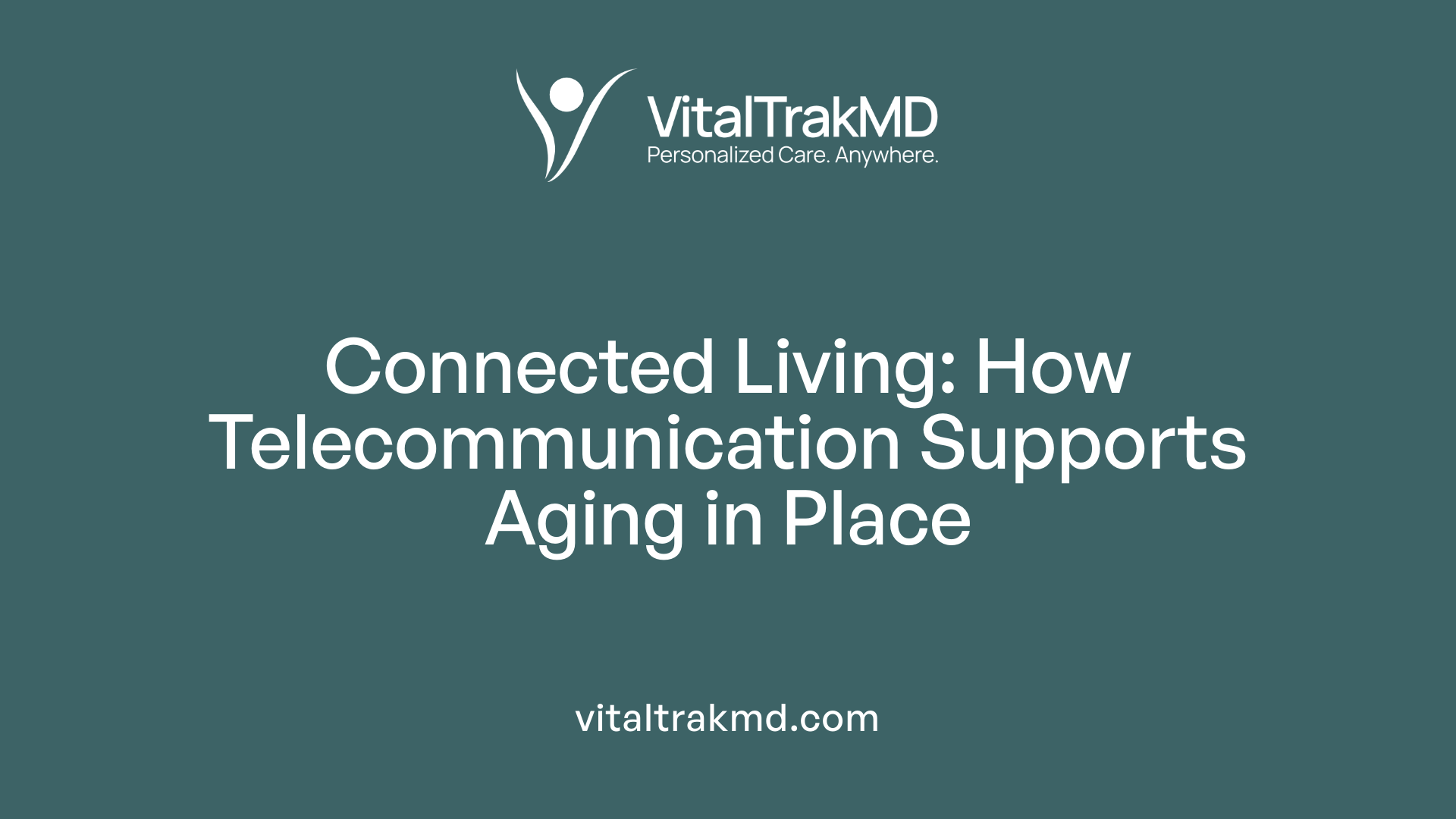TeleCheck-Ins: A Convenient Option for Busy Seniors

Supporting Aging in Place Through Reliable Technology
As seniors strive to maintain independence and health while managing busy schedules, technological solutions like TeleCheck-Ins offer invaluable support. These programs enable continuous monitoring, facilitate connection to healthcare providers, and improve safety—making aging in place both feasible and secure. This article explores the various check-in options available, the benefits and challenges of these services, with a special focus on the innovative TeleCheck-Ins program, and how it contributes to the well-being of seniors.
Available Check-In Options for Seniors: Phone Calls, Texts, and Specialized Apps

What are the available check-in options for seniors, such as phone calls and SMS communication?
Seniors have access to a range of check-in options that help ensure their safety and well-being while maintaining independence. One of the most universal methods is automated phone calls, which are muscle-memory friendly and can be answered easily by pressing buttons. These calls are scheduled at regular times to confirm the senior is okay. Many communities, often with support from police or sheriff departments, offer such services that contact seniors daily, providing reassurance and early detection of issues.
In addition to calls, SMS text messages are an effective way for seniors to confirm their safety. This method benefits users with hearing or visual impairments, as text can be read or responded to conveniently. Most seniors (92%) own some form of cellphone, and 61% own smartphones, making SMS a widely accessible communication option. However, only a small portion (12%) rely solely on landlines, highlighting the importance of mobile devices in these safety programs.
Specialized apps like Snug further enhance safety. Snug is a free check-in application that prompts seniors daily to confirm they are safe. If there is no response, the app can notify emergency contacts or even dispatch in-person wellness checks through police officers for a premium plan ($10/month). This hybrid approach, combining calls and SMS, offers flexibility to match different habits and abilities of older adults.
Community-based programs, such as Ohio’s 'Staying Connected' initiative, illustrate how automated call services operate effectively. Participants receive daily calls within a designated time window, where they can confirm their well-being or request assistance. If initial efforts fail, follow-up contacts are made, including reaching out to emergency contacts or non-emergency law enforcement. These services are crucial during events like the COVID-19 pandemic, ensuring continuous support for seniors living alone.
Beyond communication tools, wearable aid devices also play a significant role. Medical alert systems—worn as help buttons—cost roughly $1 per day and can summon emergency services instantly. Smart speakers like Amazon Alexa or Google Home can be integrated with third-party services such as Alexa Together to facilitate emergency calls through voice commands, making assistance accessible even for those with mobility challenges.
Overall, these varied options—ranging from simple phone calls and texts to advanced apps and wearable devices—help reduce loneliness, monitor safety, and provide rapid response capabilities. They form a comprehensive safety net that supports seniors living independently, giving peace of mind to families and caregivers alike.
Benefits and Drawbacks of Check-In Services for Seniors

What are the benefits and drawbacks of different check-in services for busy seniors?
Check-in services designed for seniors play a vital role in enhancing safety and fostering independence. Automated call and SMS check-ins, such as those offered by ConfirmOk, provide scheduled reassurance that seniors are doing well. These regular contacts help detect emergencies early, allowing prompt responses from family members or emergency services. Programs like Ohio’s 'Staying Connected' facilitate daily, free phone check-ins, operated within designated hours, creating an additional layer of safety that can be especially reassuring for those living alone.
In addition to safety, these services contribute positively to mental health. Knowing someone is checking in regularly can reduce feelings of loneliness and social isolation, which is common among seniors living independently. Many of these services are easy to access, with options compatible with landlines, mobile phones, or modern smartphones. For example, most seniors own some form of mobile device—about 92% own a cellphone, with 61% owning smartphones—making it easier for them to stay connected.
However, there are some challenges to consider. Not all seniors are familiar or comfortable with technology, which can hinder effective use of digital tools like SMS check-ins or smartphone apps. While muscle-memory friendly phone calls are universally accessible, technology-based services may require training or ongoing support. Privacy concerns may also arise, as continuous monitoring or regular check-ins involve sharing personal health and location information, raising questions about data security.
Costs vary depending on the service; while many programs, such as the Ohio initiative, are free, premium options like Snug's in-person wellness visits can cost around $10 per month. Additional expenses might include devices like medical alert systems or smart home gadgets, which, although beneficial, can represent financial burdens for some families.
In sum, check-in systems are valuable tools in supporting senior independence and safety. Their flexibility—ranging from traditional phone calls to integrated smart-home solutions—can be tailored to individual needs. Still, addressing technological usability, privacy, and affordability remains essential for maximizing their effectiveness.
The TeleCheck-Ins Program: Supporting Independence and Well-Being

What is the TeleCheck-Ins program, and how does it support seniors' well-being?
The TeleCheck-Ins program is a free, confidential service specially designed to help older adults in Dufferin-Caledon maintain their independence and safety while living at home. Aimed at adults aged 55 and above, this program provides scheduled check-in calls that serve multiple purposes. These calls help seniors stick to health routines, stay socially connected, and access community and health resources. By offering regular contact, the program promotes emotional well-being and helps prevent feelings of loneliness.
At its core, the program ensures safety by verifying the senior’s well-being once every 24 hours through simple phone interactions. If a senior does not respond, immediate steps are taken to escalate the situation, including contacting emergency services if necessary. This quick response system provides peace of mind to both seniors and their loved ones.
How does the program verify safety and promote social engagement?
The core function of TeleCheck-Ins is through scheduled phone calls that seniors can easily answer. These calls are designed to be muscle-memory friendly, making them accessible for seniors with mobility challenges. During each call, the senior confirms they are okay by pressing buttons or replying to a prompt.
This routine not only verifies safety but also fosters regular social contact, which is especially important for seniors living alone. The interaction, although brief, contributes significantly to their mental and emotional health. Some adaptations include offering language translation services, ensuring that language barriers do not hinder participation.
Is the program available to all seniors, and how accessible is it?
The service is available to eligible seniors in the community regardless of language or background. Community organizations and local governments work together to support its availability and accessibility. One notable feature is the partnership with organizations that offer translation services, making the check-ins understandable for non-English speakers.
Additionally, the service operates during daytime hours, from 7 a.m. to 6 p.m., within a set one-hour window, which participants select when registering. This flexibility ensures the calls fit into the seniors’ daily routines.
What happens if a senior cannot answer the call?
When a call is unanswered after three attempts, the program escalates the situation by contacting an alternate specified person, such as a family member or caregiver. If there is still no response, the protocol includes reaching out to non-emergency services of the local sheriff's office or other community support agencies.
This multi-tiered approach guarantees that seniors receive the attention they need promptly and prevents potential emergencies from being overlooked.
How do community organizations and local governments contribute?
Local police departments, sheriff’s offices, and aging agencies play a vital role by promoting the program, helping with outreach, and supporting its operation. They often subsidize or directly provide these check-in services, emphasizing community safety.
The Ohio Department of Aging’s 'Staying Connected' initiative is a prominent example. It offers free daily calls to older Ohio residents, providing reassurance and immediate connection to help if needed. Participants can access more information through dedicated websites or helplines, ensuring widespread awareness and participation.
| Aspect | Details | Additional Information |
|---|---|---|
| Target Age | 55+ | Primarily for residents in Dufferin-Caledon |
| Session Frequency | Daily | Scheduled within a chosen one-hour window |
| Response Method | Button press or voice reply | Designed for muscle-memory friendliness |
| Escalation Protocol | Multiple call attempts | Contacting family or emergency services |
| Accessibility | Language translation | Ensures inclusivity across diverse populations |
| Community Role | Local police and aging agencies | Promote, support, and fund the service |
| Additional Features | Emergency connection, social engagement | Helps reduce isolation and improve safety |
Overall, the TeleCheck-Ins program represents a comprehensive community effort to support senior independence through reliable, accessible, and responsive check-in services.
How TeleCheck-Ins Maintains Connection with Healthcare Providers and Facilitates Aging in Place

How does TeleCheck-Ins help seniors stay connected with healthcare providers?
TeleCheck-Ins significantly improves how seniors communicate with healthcare providers by using a mix of remote connection methods. These include video conversations, phone calls, and secure messaging platforms that allow for ongoing health monitoring without the need for physical visits.
Through regular check-ins, healthcare providers can observe and assess a senior’s health status, enabling early detection of issues such as infections or medication side effects. This proactive approach helps prevent health emergencies and ensures timely intervention.
The integration of remote monitoring devices complements these communications. Devices like blood pressure cuffs, pulse oximeters, and thermometers provide real-time data that healthcare professionals can access remotely. If any vital signs fall outside normal ranges, providers can promptly adjust medications or recommend further care.
Furthermore, TeleCheck-Ins support coordination with family members and caregivers. Whether through shared access to health records or direct communication channels, these systems foster a comprehensive view of the senior’s health and well-being.
For seniors with sensory impairments or mobility challenges, the user-friendly design of telehealth platforms makes engagement easier. Features such as large screens, simplified interfaces, and voice-activated controls help ensure all seniors can participate actively in their healthcare.
Overall, TeleCheck-Ins enables seniors to remain independent while maintaining essential ties with healthcare providers. It delivers a convenient, versatile, and secure way for older adults to manage their health from the comfort of their home, promoting aging in place with dignity and safety.
| Communication Method | Description | Benefits |
|---|---|---|
| Video Calls | Face-to-face virtual meetings | Visual assessment, emotional support |
| Phone Appointments | Listening and speaking interaction | Easy access, muscle-memory friendly |
| Secure Messaging | Text-based health updates | Record keeping, non-urgent communications |
| Devices and Monitoring | Usage | Purpose |
|---|---|---|
| Blood Pressure Cuffs | Remote blood pressure readings | Monitor hypertension |
| Thermometers | Track body temperature | Detect infections early |
| Pulse Oximeters | Measure oxygen saturation | Address respiratory issues |
| Overall Impact | Benefits for Seniors | Support System |
|---|---|---|
| Continuous Monitoring | Early detection and intervention | Healthcare providers, family members |
| Improved Independence | Reduce hospital visits | Seniors living at home |
| Enhanced Safety | 24/7 oversight | Peace of mind for loved ones |
These technological tools and communication channels help create a reliable and accessible healthcare experience for seniors, aiding their desire to stay independent and healthy in their familiar surroundings.
The Role of Telecommunication Technologies in Supporting Independent Living

What role do telecommunication services like TeleCheck-Ins play in enabling independent living and aging in place?
Telecommunication services such as TeleCheck-Ins are vital tools that help seniors maintain independence by ensuring consistent connectivity to essential services and loved ones. These automated systems offer scheduled contact, typically through phone calls or SMS messages, verifying the senior’s well-being. If the senior cannot respond or is in distress, the system automatically escalates the response by alerting caregivers, emergency contacts, or local authorities. This proactive approach reduces the risk of unnoticed health emergencies or safety issues.
Several programs exemplify the positive impact of these services. For example, Ohio's 'Staying Connected' program provides free daily check-ins via phone to residents aged 60 and over, supporting their health and emotional well-being. The service operates within a specified time window, confirming the senior’s safety and offering local assistance if needed. If unable to reach the individual after multiple attempts, the system reaches out to additional contacts or emergency services, ensuring continuous safety monitoring.
Beyond simple check-ins, advanced telecommunication platforms integrate features like Resident Locating and Wander Management systems. These tools are especially useful for seniors with memory issues or mobility challenges, providing rapid location services if the person wanders. Telehealth solutions further extend support by enabling remote medical consultations and quick access to healthcare providers, making ongoing care possible without leaving home.
In addition to dedicated check-in systems, many communities rely on programs subsidized by police or county offices, providing automated calls that promote daily safety routines. These initiatives underscore the importance of reliable, accessible communication channels in reducing risks and fostering independence.
Overall, telecommunication services act as a safety net, reinforcing seniors' ability to live at home confidently and comfortably, with immediate support available if needed.
How to Sign Up for TeleCheck-Ins and Access Available Resources

How can seniors sign up for TeleCheck-Ins or similar programs, and what resources do these programs offer?
Seniors interested in maintaining safety and staying connected can easily register for programs like TeleCheck-Ins through multiple channels. Typically, registration can be completed via healthcare providers or local community organizations that support senior services. These entities often serve as the primary access points, guiding seniors through the sign-up process.
Additionally, many programs provide online platforms for registration. For instance, using official websites or dedicated registration portals allows seniors or their caregivers to enroll conveniently from home. The Ohio Department of Aging’s 'Staying Connected' program, for example, can be accessed through their website at www.aging.ohio.gov/stayingconnected. There, seniors can fill out registration forms and set their preferred check-in times.
For those who prefer direct communication, helplines and phone registration are available. Calling designated numbers such as 1-833-ODA-CHAT or contacting local senior centers can facilitate the enrollment process. These helplines also serve as valuable resources for answering questions and guiding seniors through the process.
Once enrolled, seniors gain access to a range of support services through these programs. Scheduled check-ins are one of the primary features, where automated calls or texts verify that the senior is safe and well. These check-ins not only provide peace of mind but also include options for connecting seniors with emergency services or community resources if needed.
In addition to routine check-ins, members of these programs often receive alerts for emergencies or health concerns. Community contacts, such as local police, sheriff’s offices, or designated emergency contacts, are integrated into the system to respond swiftly if a senior fails to respond.
Seniors can also benefit from resources like medication reminders, wellness monitoring, and detailed communication channels with caregivers or family members. These support systems help seniors live independently while ensuring that help is available if required.
To manage and update registration details, seniors or their authorized representatives are encouraged to contact the program administrators via phone or online portals. Keeping information current ensures that the services function smoothly and that seniors receive assistance tailored to their habits and evolving needs.
In summary, enrolling in programs like TeleCheck-Ins involves straightforward procedures accessible through healthcare providers, community organizations, or online platforms. Once registered, seniors enjoy consistent safety checks, reliable emergency alerts, and strong links to community support—tools that foster independence and peace of mind.
Empowering Seniors Through Technology for a Safer Future
Incorporating services like TeleCheck-Ins significantly enhances seniors’ ability to live independently and with confidence. By providing reliable communication, health monitoring, and quick access to emergency assistance, these programs address the unique needs of aging populations. As technology continues to evolve, these solutions will become even more integral in supporting a high quality of life for older adults, ensuring they remain connected, safe, and engaged within their communities.
References
- SMS or Phone? Best Check-in Option for Seniors
- Daily Check-In Services for Seniors Living Alone
- Ohio Department of Aging launches free check-in service for ...
- Telemedicine: easier access to care for older adults during ...
- The Best Smart Home Devices to Help Aging in Place
- Convenient Tech Tips For Older Adults
- Telecheck Info - Kentucky Department of Fish & Wildlife
- Check-In Services for Seniors: Daily Phone Calls for Elderly
- Senior Check In Services and Welfare Checks
- Recommendatons for daily check-in services
Recent articles
Want to Feel Better and Live Healthier?
Join hundreds of patients taking control of their health with personalized care that fits their life – not the other way around.
Rated 4.8/5 by 32+ customers







